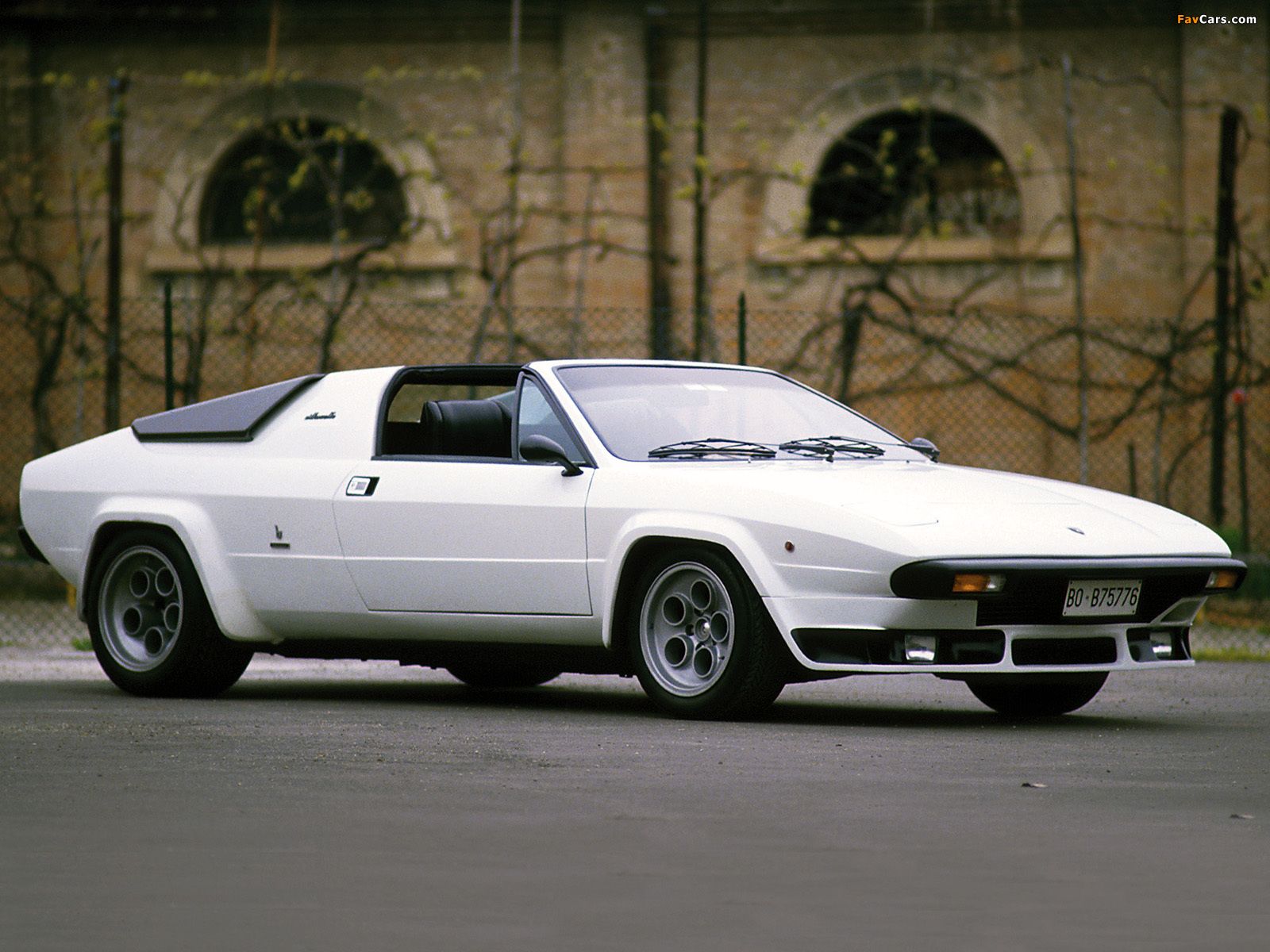Once upon a time, the almighty Lambo we know today was desperate for survival. The Silhouette helped drive Lamborghini back from the brink of disaster. The Italian automaker was fighting for breath and needed redemption real quick, and the company found a messiah in the Silhouette. Finally launched at the Geneva Auto Show 1976, Lamborghini Silhouette had a messianic 3-year run.
The mid-engined sports car provided Lamborghini with the much-needed oxygen and didn’t seem to mind that Countach hugged all the attention. Ah, what things we can learn from such a selfless Lamb who fought the bull’s battle with fewer rounds. Just 54 Silhouettes were made, but the iconic model helped chart the course of Lambo’s return to glory. Silhouette morphed into the even more successful Lamborghini Jalpa, continuing Lambo’s storied rise.
Lamborghini Uracco (little bull) P300 was a fierce little bull that couldn’t ram the market, even though it had close to seven years to do just that. Urracco failed, and Silhouette zoomed to the rescue. The Italian automaker sold just 700 plus Urraccos in all the seven years it was in production.
Silhouette was Lambo’s first-ever Targa-style soft-top, although the 2-passenger car was based on the Uracco P300 that turned out a commercial failure. Lambo’s owner, Ferruccio, specifically told Bertone of Gruppo Bertone, that he needed the Uracco P300 reinvented as a sales-boosting, different-looking true bull. The Silhouette was Bertone’s answer; an ostensible 2-door rear-wheel-drive little fierce bull.
Who Designed The Lamborghini Silhouette?
There was not such a striking difference in design between Urracco and Silhouette. Silhouette’s Targa-top roof is the most distinct dissimilarity between the two cars. Even so, you would never mistake Silhouette for Urracco, although designers from the same styling house made both cars. Marcello Gandini designed the Urracco and Giuseppe Bertone (Nuccio) designed the Silhouette.
Born in the metropolitan Italian city of Turin, Bertone died in 1997 in the same city of his birth, but Gandini is still alive and kicking as of 2022. Nuccio may be dead, but the company he took over from his father after the Second World War and grew into the building and designing powerhouse known as Carrozzeria Bertone Styling House lived on until bankruptcy took the company out of business in 2014.
Actually, Bertone’s widow, Lilly Bertone, remained at the helm of the company’s affairs until the company’s collapse. By then, the renowned automobile design studio had styled iconic cars, including Aston Martin, Volvo, Mercedes-Benz, BMW, Alfa Romeo, and Lamborghini.
Despite the cosmetic similarities of Lamborghini Silhouette and Urracco, it’s not exactly correct to call the former a replacement or successor of the latter. You could see traces of the Urracco in Silhouette; the pop-up headlamps, front bumper, and overall nose profile. But in terms of exterior proportion, Silhouette possessed a more angular styling. Plus, Bertone got rid of Urracco’s front vented lid, replacing it with a solid panel.
You could also spot Urracco’s deck lid, tail, and rear light on Silhouette’s behind, but the latter featured a bigger bumper that swelled its ass. Some would say there was none prettier than the Silhouette among junior supercars of the 70s.
There were other carryovers, but Silhouette seemed to always have a new feature to offset any residue from Urracco. Its angular proportions promoted Lambo’s signature beastly look. To top it off, Silhouette was 35 mm longer, 140 mm wider, and 40 mm lower than Urraco.
How Many Lamborghini Silhouettes Were Made?
Lamborghini made only 54 Silhouettes. Yep, that’s what happens when you don’t sell in America. You could say the same thing about the one that came before it. Urracco did not have the modification required for approval to sell in the USA. Looking back from where Lamborghini stands today, that’s okay. After all, Honda did plenty of kowtowing to please the US regulatory bodies, but the Honda S800 never made it officially to the US market before going kaput.
Some Silhouettes did make it across the Atlantic, but not officially. As if that isn’t tough enough, twelve out of the paltry fifty-something Silhouettes produced were right-hand drives. The Silhouette was born amidst internal hoo-ha as Ferruccio made his exit from the company he founded. He sold his last share in the company about two years before Silhouette rolled out of the Sant’Agata Bolognese plant.
Urracco didn’t come at the best of times, neither did Silhouette. As if the oil crisis wasn’t bad enough, Italy was grappling with insurrections and riots, and the unrest was closing in on Bologna, the location of Lamborghini’s production facility. Lamborghini’s new owners under Georges-Henri Rossetti and René Leimer introduced the model Jalpa in 1981 to take over from where the road ended for Silhouette.
How Much Is A Lamborghini Silhouette?
Oh, someone wants to buy a Lamborghini Silhouette? Maybe you haven’t been listening; only 54 were made. The Silhouette is one of the rarest Lambos ever. A 1976 Silhouette was sold at Mecum Auction for $130,000 in 2016. Before that, a 1978 Silhouette sold for $60,000 in 2010. There were 31 of them left in the world in 2019. How many are left today? Your guess is as good as mine.
Internal and societal crises weren’t the only reason Silhouette didn’t fly off dealerships. If it was, then why did Silhouette’s successor sell only around 400 units, and that was a success story by Lamborghini’s standards? The truth is, Lambos have always been expensive.
Automobili Lamborghini sold 8,405 cars in 2021. Compare that to Toyota’s 1.6 million units sold that same year. Wondering why shoppers looked past the Silhouette in favor of Ferrari 308 and Porsche 911 is like wondering why Audi R8 or Mazda MX-5 enjoys more sales than Aventador.
Exactly, that’s why Ferrari sold 12,000 units of the 308 in 1978 while Lamborghini sold a mere 420 Jalpas in seven years. By technicalities, why would anyone choose Ferrari 308 over Lamborghini Silhouette? $27,000, that’s why. It cost $27k to own a Silhouette in 1976. That’s approximately $135,633 in today’s money. We’re talking about a time when the average cost of a new car was $5,400.
Another problem; the automaker’s internal predicament was no secret. So, Lamborghini’s target customers were skeptical of the company’s future. Wouldn’t you be wary investing in a super-expensive sports car, you aren’t sure of the availability of replacement parts down the road?
There is something to be said about making lemonade when you are handed lemons. Lamborghini didn’t start out wanting to make exclusive cars that a few could buy. The board certainly wasn’t thinking that way in 1978 when Jalpa was launched. In fact, the company’s vision for Urracco was a high-volume junior sports car.
Unfortunately, Urracco flopped in sales, bringing in just 10{09e594db938380acbda72fd0ffbcd1ef1c99380160786adb3aba3c50c4545157} of the company’s sales target. But since cash-strapped Lambo had to make a limited number of cars, they found a niche making cars for the few with taste and a fat wallet. Did it work? You tell me.
Read Next
About The Author



